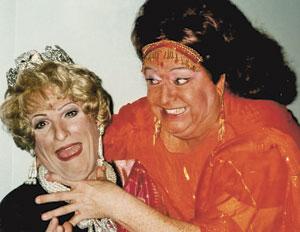A sure sign of spring in Vancouver is the advent of each year’s Empress Ball. There are hints of it everywhere right now. Amidst the rustle of silk and swish of chiffon, the glitter of rhinestones and clatter of spike heels, the men in dresses are getting ready for the highlight of their year.
I confess to a soft spot for men in dresses because, along with many of my generation, I know they were our community’s earliest freedom fighters. From the rage of the Stonewall riots of 1969 to the celebrated “Hookers on Davie” of the ’80s, they were the ones who endured public scorn and frequent violence in the early struggle to stake out a safe place in the world for all of us.
I use the phrase “men in dresses” because it is a term that ted northe, Empress of Canada and founder of Canada’s court system, uses to describe himself, and somehow it resonates. We now understand that there is a not always coherent continuum from those men in dresses through drag queens to transvestites to transsexuals to . . . well, where will it end? We continue to explore our horizons.
But for many of us an understanding of that world began with men in dresses, and it is those pioneers I salute today as their successors prepare for the March 17 Coronation XLI and Empress XL Kamelle Toe’s passing of the gilded baton.
Let me tell you about the first time I ever saw men in dresses. The setting was the tiny basement stage at Davie St’s Champagne Charlie’s in the spring of 1970. Dee Dee Ambrose was the reigning diva, and her doo-wop girls were the whip-slender Sandy St Peters and the tall, legs-up-to-here Charity.
Champagne Charlie’s was a dimly lit poor man’s vision of the Moulin Rouge. All blood-and-bruises colouring, dark corners and cabaret tables fanned out around a tiny central stage area, not much bigger than your kitchen floor.
As I edged my way to a table, the ’70s club music gradually faded and suddenly the room was filled with the theatrical, booming voice of DJ Doug Reid announcing, “Good evening ladies and gentlemen,” (was he talking about us?) “and welcome to Champagne Charlie’s! . . . And now, the stars of our show, Mr Dee Dee Ambrose (pause for applause) . . . Charity! (more applause) and (pause) Mr (pause) Sandy (pause) St Peters!”
The house went wild, in a peculiarly ’70s kind of room-full-of-fags-going-wild way, and the show was on.
For this first-timer it was exciting to witness these larger-than-life self-made creatures reach down deep into their innermost beings to play out under the spotlights fantasies that many of the rest of us had perhaps rehearsed more modestly in our bathrobes and a pair of Mom’s earrings.
If you are of a certain age you might have been there that night, too. I can imagine you smiling a bit now as you tap your toes to the remembered music. Was it “If You Don’t See What You Want Up Here,” or “Cocktails for Two”? Or the irresistible Salvation Army song that was one of Sandy’s signature pieces?
If you weren’t there, you must remember other magic-filled nights when men in dresses created a private and slightly subversive world where we could sing along with Mae and Sophie and Judy, and later Liza and Tina and Barbra, and indulge whatever fantasies we might, safe from the eyes of a judgmental world.
From the stars of that night at Champagne Charlie’s, through the decades that brought us Bill Harvey and Bobbie Callicoatte, not to forget Starlette and Dusty Ryan, down to more recent divas like Willie Taylor and Joan-E, it’s been men in dresses who have entertained us, rallied our sense of community, and tirelessly raised funds for countless worthy causes — all of which they continue to do.
Google “Vancouver drag queens” and you’ll find that many performances of the past decade are posted for posterity. What a pity we didn’t have YouTube in the ’70s!
I have a dear friend who loathes drag queens, likening them to blackface minstrel shows. I doubt we’ll ever be able to discuss the topic rationally, because my affection for men in dresses isn’t rational. I just know that they are among my heroes.
Party on, girls!

 Why you can trust Xtra
Why you can trust Xtra


